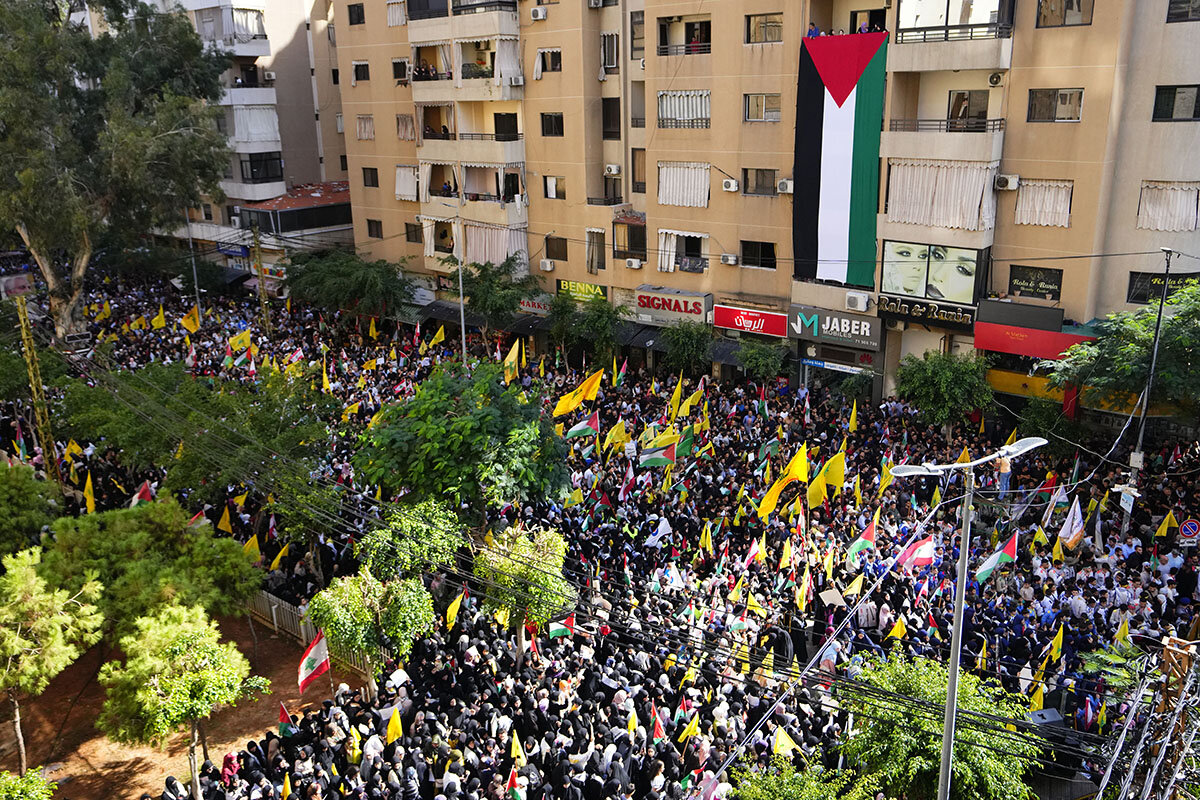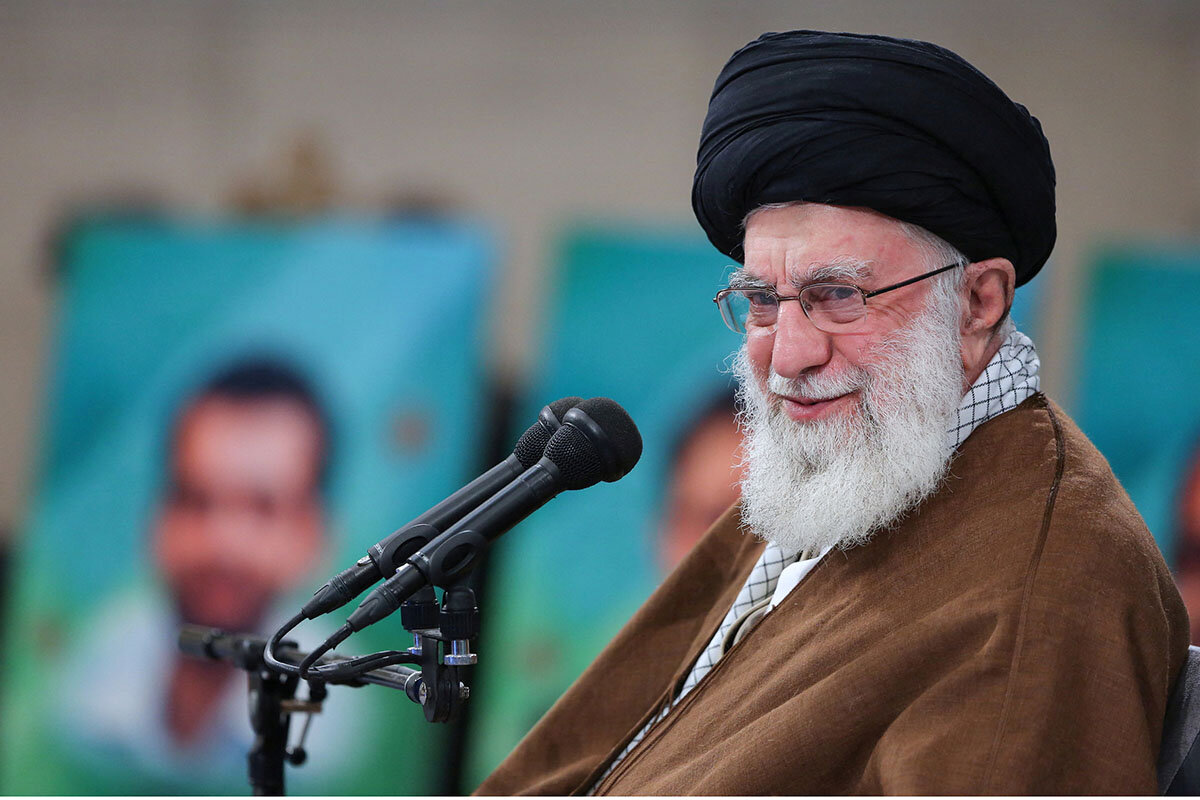Gaza crisis: After strategic gains, Iran pivots to prevent losses
Loading...
| London
Iran’s stark warning to Israel about triggering a wider regional war – with Iran-allied militias attacking on three fronts, if Israel continues bombarding Gaza – came in the form of a special report on Iranian state-run television.
The Oct. 18 TV broadcast shows every arm of Iran’s anti-U.S. and anti-Israel alliance using Iranian missiles and rockets to attack and swarm Israel. The portrayed offensive would build on the surprise Oct. 7 incursion by Iran-backed Hamas, which stunned Israel with its savagery, and left 1,400 Israelis dead and more than 200 as hostages.
More than 6,000 people have since been killed in Gaza, Palestinian officials say, amid relentless Israeli airstrikes and shelling that have displaced hundreds of thousands of civilians. Israel has massed its forces for a ground invasion, and Israeli officials say it will “destroy” Hamas in Gaza – a result Iran says is unacceptable.
Why We Wrote This
Since the Hamas-Israel war erupted, Iran and its other regional allies have been arrayed against Israel and the United States, which has deployed forces. Iran’s balancing act now is to preserve what it has gained, without the costs of a wider war.
The Iranian broadcast intersperses scenes of carnage in Gaza with missile launches and shows Iran’s supreme leader, Ayatollah Ali Khamenei, warning in a speech that Iran-backed fighters will “become restless” and “nobody will be able to stop them” if Israel does not stop its “crimes” in Gaza.
“If the Resistance Front loses patience and decides to take action against the Zionist regime, it will do so from as far away as 2,000 kilometers,” says the narrator on Iran’s state-run IRINN. Red arrows show Iran-backed Hezbollah targeting Israel from Lebanon in the north, Syrian and Iraqi militia from the east, and Houthis from Yemen from the south.
The graphic shows explosions rising repeatedly from Israel, which is depicted as a broken Star of David.
While the Iranian broadcast and state-run newspapers seek to capitalize on high emotions in Iran over Gaza and project a sense of readiness with headlines such as “Impatience for the Zero Hour,” it is only one side of Iran’s careful balancing act.
For even as Iran aims to continue hurting its archfoes Israel and America with the calibrated use of its regional militia allies, it also seeks to avoid an all-out regional war. Such a conflict could reel in Hezbollah, Iran itself, and the United States – and jeopardize the deterrent power of Iran’s regional alliance, its self-declared “Axis of Resistance.”
Analysts say Iran relishes what it terms Hamas’ “achievement” against Israel, and while Iran was instrumental in enabling the audacious Hamas attack – with cash, smuggled weapons parts, and shared asymmetric military know-how – Ayatollah Khamenei was also quick to deny any direct Iranian role in the assault.
Yet critical to Iran’s calculations may also be ensuring the survival of Hamas or risking appearing weak.
“The big achievement is there, which is rebalancing vis-a-vis Israel through more effective deterrence; you don’t need more,” says Hassan Ahmadian, an assistant professor at the University of Tehran. “But you also need to make sure that your allies are there, survive, and can continue. As the main party that supports Hamas, and others in the region, your credibility is also at stake – you can’t just turn a blind eye.”
Iranian “pushback”
For years, Iran had felt that Israel had been “inching closer to Iran, so a pushback against that and rebalance was expected,” says Dr. Ahmadian, noting growing Israeli influence in Iraqi Kurdistan and neighboring Azerbaijan, as well as Israeli actions targeting Iran – from Syria to inside Iran itself.
“Hamas’ priorities came in line with Iran’s interests. They called the shot, but the Iranians were happy about it; this is what they were after,” says Dr. Ahmadian. “The Iranians feel that consolidating the balance has already been achieved. In line with this, Iran’s allies should be saved as well.”
That is one reason Iranian Foreign Minister Hossein Amir-Abdollahian warned the U.S. Monday to “stop the war before it is too late” in a region that could “spiral out of control any minute.”
“The lines drawn in Tehran and in Beirut [by Hezbollah] are clear that [Israel’s] moving into Gaza would spark a major conflict, which means Hezbollah moving heavier toward a collision course with Israeli forces – not necessarily waging total war, but increasing the heat there,” says Dr. Ahmadian.
“The most visible scenario for me is that Hezbollah would increase the heat to a level that makes Israel really revisit its strategy against Gaza – then you could see attacks also from Syria, Iraq, and maybe from Yemen,” he says.
Already, Israel’s northern border with Lebanon has been rocked by multiple skirmishes with Hezbollah and led to the evacuation of Israeli civilians from the border region. U.S. troops on bases in Iraq and Syria have come under rocket fire and drone attack from Iranian-backed groups.
U.S. messages and maneuvers
The U.S. has promised Israel unwavering support in its response to the Hamas attack and has sent forces to the region, but it has also counseled Israel to delay its ground offensive to allow for the delivery of more humanitarian aid, the release of more hostages, and the deployment of key U.S. military units, including missile defenses.
A U.S. Navy destroyer in the northern Red Sea and a missile battery on Saudi soil last week shot down four cruise missiles and 15 drones that were launched by Houthis in Yemen and apparently aimed at Israel.
On Oct. 13, Secretary of State Antony Blinken delivered a message to Iran via Qatar that the U.S. did not want a wider war, and that Iran and Hezbollah “must exercise restraint.”
Yet on Sunday, Secretary of Defense Lloyd Austin cited “recent escalations by Iran and its proxy forces” across the Middle East when he ordered a second aircraft carrier strike group that was en route to the eastern Mediterranean and redirected to an area closer to Iran.
“Iran doesn’t have the desire to enter into a broader conflict itself, and most probably it also doesn’t want to see Hezbollah comprehensively involved in that,” says Hamidreza Azizi, an Iran expert at the German Institute for International and Security Affairs in Berlin.
“In the eyes of Iranian leaders, what they could possibly achieve against Israel has already been achieved as a result of this Hamas attack,” says Dr. Azizi. “They have been under criticism by their own support base ... for not showing enough strength in the face of Israeli covert actions inside Iran, in Syria, and Iraq.”
He cites assassinations widely attributed to Israel of a number of key nuclear scientists and a top missile specialist, sabotage of Iran’s nuclear facilities by Mossad operatives, and frequent airstrikes against Iranian and allied militia targets in Syria and Iraq.
“Those ultra-hard-liners, who form the only support base left for the Islamic Republic, were getting more and more unhappy with the trend,” he says. “Now, after all these years of propaganda – and of course there is some reality in that – about this unified front supported by Iran, they can claim that they have already taken revenge for Israeli actions.”
For Iran, the “most desirable” outcome now is for clashes to stop and the status quo to remain, says Dr. Azizi. “Iran would not have a problem with a cease-fire because the damage [to Israel] is done already, and the so-called Resistance forces will have enough time to regroup and plan for the next phase.”
There are also significant domestic issues at play for Iran, such as an economy crippled by U.S.-led sanctions and government mismanagement, and deep unhappiness with the Islamic Republic, as expressed by months of women-led street protests that began last year.
The chant is often heard at protests: “Neither Gaza nor Lebanon, I sacrifice my life for Iran.”
Khamenei’s legacy
Avoiding a regional war may also be a personal issue for the octogenarian Ayatollah Khamenei, says Dr. Azizi.
“Khamenei obviously doesn’t want ... to be remembered for bringing the country into war and devastation,” he says. “All the other actors involved in the post-Khamenei transition do not want this process to be disrupted, or war to contribute to domestic unrest, and the situation to get out of hand.”
The challenge for Iran is made deeper by its recent outreach to Arab nations, which included reestablishing ties last spring after seven years with Saudi Arabia. A year of indirect negotiations with the U.S., brokered by Qatar, led to a prisoner exchange in mid-September.
Reports at the time indicated a further agreement for the U.S. to ease enforcement of sanctions, if Iran slowed down progress on its nuclear program and tempered the attacks by its allied regional militias.
“We are in contact with our friends Hamas, Islamic jihad, and Hezbollah,” the head of Iran’s parliamentary National Security Committee, Vahid Jalalzadeh, said last week. “Their stance is that they do not expect us to carry out military operations.”
An Iranian researcher contributed to this report.








